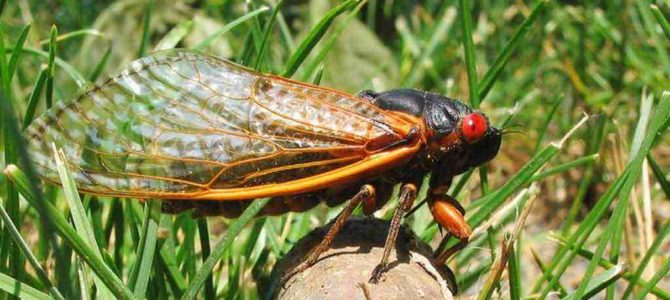
They have arrived. Those giant, buzzing scourges of summer. Here in the mid-Atlantic, periodic cicadas that should be in the last third of a 17-year hibernation right now have emerged four years early, according to scientists.
This is presumably because they heard how awesome 2016 was and didn’t want to miss anything else. These slow, bulbous insects mature underground, an army of nighmare-ish larvae less than a yard beneath our feet, before emerging in great numbers once the ground temperature alerts them that it’s time to come out and torture us.
Often confused with locusts— or deliberately slandered, haters— these clumsy insects are hated for a reason. They’re big, they’re loud, they fly directly into things because they don’t know any better, and there are just so many of them. There are so many of them because they’re dim and clumsy, so species survival dictates they march forth in thousands like so much cannon fodder before our loafer bottoms, toddlers’ tricycles, and various predators.
The evidence of their existential struggle is everywhere— in generous, meaty splats on windshields, in rotting red-eyed carrion upon the sidewalk, in the intricate wings your child is collecting in what may or may not be a sign of sociopathy, and, of course, in the ghostly little exoskeletons they shed on trees and bushes.
So, what to do? Embrace the invasion. Here are five ways.
1. Play Games!
Cicada shells are great for pranks. There should be no set of siblings who has not pranked their mother or each other by sticking these little velcro buggers on an unsuspecting victim’s shirt.
They also make for freaky-good clip-on earrings for those who are comfortable grossing out others by their close proximity to such things.
2. Teach Your Kids
Kids love gross stuff. Cicadas are basically the Garbage Pail Kids of nature—the size, the red eyes, the weird sounds, the molting. I have a childhood memory of my dad patiently photographing a cicada emerging from its exoskeleton on the bark of a tree in our backyard. For years, I’d look at those pictures and ask questions about cicadas that led to other naturalistic and scientific pursuits. (Now, I’m a writer and political commentator, so experience does not necessarily predict proficiency, but still fun.)
There are plenty of children’s books on cicadas— both educational and storybooks. “Cecily the Cicada” is coming to our house this summer, for sure.
3. Eat Them? Sure, Eat Them!
Low in fat, carbs, and gluten-free, these arthropods are the perfect amuse bouche for your next neighborhood dinner party. They’re plentiful, local, sustainable, and just weird enough for some hipster culinary cred. Fry them up, explain the cultural significance of bug-eating in some areas of the world, and watch worldly friends try to pretend they’re not grossed out.
Sometimes called the “shrimp of the land,” probably not by that many people but I digress, cicadas are said to taste like other arthropods of the sea—shrimp and lobster. Michael Raupp, a University of Maryland entomologist who literally wrote the book on eating cicadas, offers tips for prep and some perspective: “Boiled they’re going to taste a lot like shrimp. If you eat them au naturel, raw, they’ve got a delicate nutty flavor; a buttery texture…I like the soft-shelled ones,” which you’re most likely to find soon after they emerge from the ground in the early mornings, before they harden.
“Have you ever eaten an oyster or a clam out of the bay? It lives on the bottom of the bay and filters, you know what (feces),” Raupp told a Pennsylvania newspaper in 2013 when the last brood emerged. “You’d eat this thing, but would not eat this delectable insect that’s been sucking on plant fat for 17 years? I think it’s weird.”
Others are not as kind to the local delicacy: “When you eat one, you end up with a bunch of pointy slabs of body all over the place.” Yum!
4. Keep Your Head on a Swivel
Look, they’re not great navigators. They may fly straight into you. In a worst-case scenario, they might dive bomb your head and get caught in your hair flapping their wings violently while shrieking their distress call. Not that I know. Nothing like that has ever happened to me. Shut up, I don’t want to talk about it.
But I do know checking the scene outside the back door before you exit and wearing your hair in a ponytail if at all possible are good safety measures if one were worried about such a thing. Which I’m not. Nope.
5. Call Them Something Different
The 13- and 17-year broods are also known as Magicicadas, which is a lot more enchanting than plain old cicada.
When I was a kid, we called them katydids, which the Internet now informs me is actually a name for another loud, Southern insect with a slightly different call. Nonetheless, the katydid colloquialism is cuter than cicada and may improve your experience.
It also helps to keep in mind these big bugs are unique to North America, harmless, and carry no infections, unlike other summer bugs of the area (oh hai, ticks). There are only two ways they can hurt you: 1) If you put one on your skin and leave it long enough that the bug starts thinking you’re a tree and begins to feed on you, which is really not the cicada’s fault at that point. 2) If you pick one up while it’s doing its call and put it next to your ear. Again, the cicada should not be blamed for your cavalier approach to your hearing. But this brings me to my final point about cicadas, which should win you over forever on the cool factor of these guys.
6. Did You Know They’re Nature’s Boomboxes?
The most remarkable thing about these bugs is their giant sound. Sometimes seemingly deafening in the Southern night air, they gather in groups and call out to each other like so many maracas shaking at once. The buzzy hum can reach the decibel level of a passing train and could cause hearing damage if you subjected yourself to ludicrously close and long exposure to it.
Male cicadas, who do most of the loud calling, to protect themselves even disable their own hearing while making this call. Their method for making this unique noise is different than a cricket’s, which is a form of stridulation— rubbing wings or legs together. Instead, male cicadas have a structure on either side of their abdomens called a “tymbal,” which is made up of flexible membranes and tiny bug ribs. The cicadas can flex and relax these tymbals, creating a little click sound. CicadaMania likens it to plinking the cap of a Snapple bottle. They do it very, very fast to create the constant, high-pitched hum you hear.
But the volume level comes from the fact that their abdomens are hollow, creating an effect like the body of a guitar and amplifying the sound to, well, the level of a Metallica concert, according to the CicadaMania experts.
So, grab an Arnold Palmer, have a seat in your backyard, and welcome the bumbling and beautiful heralds of summer.









